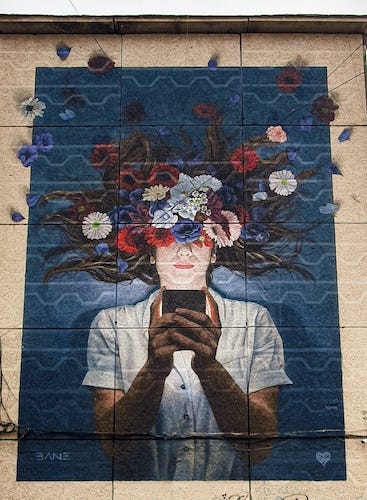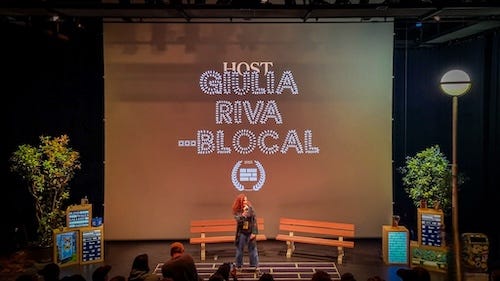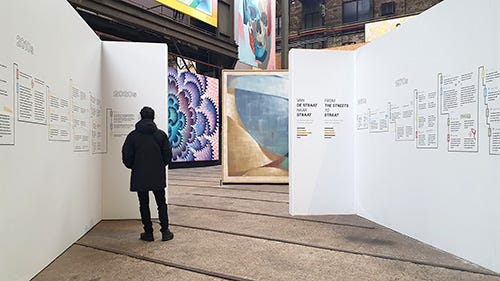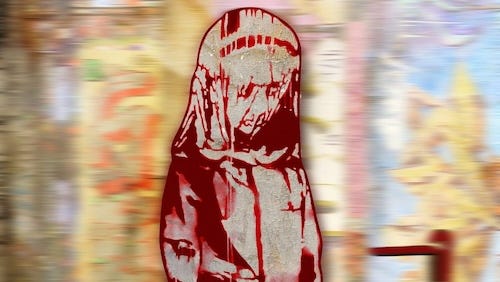👋 Ciao, I'm Giulia Blocal, your street art insider. This is Beyond the Walls, a monthly deep dive into street art, graffiti, off-the-beaten-path travel, and a bit of my life in between.
This month, we’re delving into how photography and videography have documented street art and graffiti, shaping the art form itself—a topic sparked by my recent experience working at Blind Walls Film Fest.
But first, a few updates on my life and the BLocal project.
Let’s jump in!
Ciao,
how are you?
This month, I’m writing to you from Tirana 🇦🇱 —back here for the first time in 11 years! For those who don’t know, my blog originally began as a way to share my road trips across the Balkans. Between 2008 and 2012, while living in Slovenia, I traveled extensively throughout the region, continuing even after I returned to Italy. But once I moved again—first to Bristol, then to Amsterdam—I started using my holidays to visit family and friends in Rome, and the Balkans gradually slipped off my itinerary—and further down the pages of this travel blog.
Now, though, I’m finally back in Tirana, even if just for a weekend. I’ll make sure to check out some new murals for you—stay tuned for updates on the blog to help plan your next Balkan trip!
February began with yet another trip—another return. I was invited back to Breda 🇳🇱 for the Blind Walls Film Fest, a festival dedicated to films, documentaries, and shorts exploring graffiti, street art, and muralism.
Later in this newsletter, you’ll find the transcript of a thought-provoking panel I moderated, my reflections on a film I presented about the theft of a Banksy artwork, and one of my messy vlogs, capturing the highlights of the week. 🤪
This trip also brought me back to Amsterdam -and to STRAAT Museum, four years after I quit my job there.
Amsterdam’s street art and graffiti museum was both the reason I moved to Amsterdam and the reason I left. Stepping into that familiar warehouse stirred a mix of nostalgia and detachment, warmth and unease. Some moments felt like slipping back into an old life, while others seemed distant, as if they belonged to someone else.
So many emotions to untangle, and once again, I’ll try to make sense of them through writing—just as I did back then in my blog series My Amsterdream.
But not this month. The emotions are still too raw.
For now, I’ll let it sit.
Catch you next time,
Giulia
📚 Updates on my book “As Seen on the Streets of Paris”
Big news! The book launch in Paris is set! 🎉 Join me on April 25th at Le Grand Jeu, an independent bookstore with a fantastic selection of books on graffiti, street art, and DIY cultures, run by my friend Christian Omodeo. Some of the artists featured in the book will also be there—don’t miss it! 😉
I had a meaningful conversation about the book with Sage Helene from UP Magazine—the graffiti and street art magazine where I’m usually the one asking the questions. This time, though, I was the one being interviewed. 🙂
UP Magazine - “As Seen on the Streets of Paris”
I also received two more thoughtful reviews from street art blogs I deeply admire, both of which have long been sources of inspiration for me. It’s truly rewarding to see my work recognized by platforms that share my passion for the scene.
Street Art United States - “As Seen on the Streets of Paris”
Graffiti Street - “As Seen on the Streets of Paris”
Finally, the book has made its way to the literary supplement of Corriere della Sera, one of Italy’s major newspapers!
✈️ Join Me on a Street Art Trip!
April 25 - 29: Explore Paris with me!
🛎️ Only two spots left! 🛎️
Celebrate the release of my book, As Seen on the Streets of Paris, in the very places where its stories and inspiration began! Join me for an intimate and unconventional journey through Paris, uncovering its hidden corners and diving deep into the city’s vibrant street art scene.
This trip is a perfect opportunity to experience the creativity and energy of street art in Paris while connecting with like-minded art enthusiasts. Together, we’ll explore offbeat neighborhoods, admire stunning murals, and visit iconic urban art spots. Experience Paris like never before by immersing yourself in its dynamic urban art culture and uncovering a side of the city most travelers miss.
✨ Early Bird Offer: Book before March 5th to secure your spot at a discounted rate!
Next trip:
🇵🇹 Lisbon: May 8 – 12
Graffiti on Film: Capturing, Preserving, and Transforming Urban Art.
For many old-school graffiti writers I’ve spoken with, their passion sparked the moment they flipped through Subway Art, the seminal 1984 book by Martha Cooper and Henry Chalfant. Known as 'the graffiti bible,' it didn’t just document New York’s vibrant graffiti scene—it broadcasted it to the world. Local trains adorned with daring, colorful lettering styles inspired kids in faraway cities, turning a once-local subculture into a global movement.
Preservation of the Ephemeral
Since those early days, documentation through photography and video has been indispensable in capturing the fleeting nature of graffiti. Films like the legendary Style Wars (1983) not only showcased the bold styles and intricate lettering of New York City’s graffiti writers but also brought the energy, defiance, and cultural significance of the movement into sharper focus. Street art and graffiti exist in a state of impermanence, constantly at risk of removal, weathering, or being covered by the next layer of urban creativity. Photography and video, however, extend their lifespan, transforming ephemeral works into enduring cultural artifacts.
While purists argue that this form of documentation is the only way to bring graffiti and street art into the pristine, static environment of a museum, I’m more intrigued by its narrative potential.
Through photography and video, we can capture not only the final product but also the environment that shaped it, the process of its creation, and the untold stories behind each piece.
Beyond the Walls (ha 😜)
The ability to preserve ephemeral works through photography and video doesn’t just ensure their survival; it opens up new ways to tell the stories behind them. Beyond immortalizing the finished piece, these technologies allow us to capture the grit, effort, and audacity that go into creating street art. Technology lets us move beyond the artwork on a wall, turning the creation process into a compelling narrative. It reveals the unseen: the ‘making-of.’
Admiring a mural is one thing; understanding what it takes to paint a 20-meter-high façade from a cherry picker, nose against the wall, is another. Through video and photography, people can experience the act of creation—the thrill of painting in public spaces and the profound act of reclaiming urban spaces as an artist’s canvas.
From the Streets to the Web
With the rise of the internet and social media, urban art documentation now reaches a global audience instantly, turning creation into a shared experience. The evolution of urban art parallels the world it inhabits, with a significant shift toward digital platforms.
Parisian street artist JR famously called the streets 'the world’s biggest gallery,' but today, the web challenges that claim. In a way, the digital realm has become a limitless urban space of its own, where art not only lives but thrives, endlessly shared and reinterpreted.
Today, when an artist creates in public space, they speak to two audiences. The first is the passerby, who encounters the work in its physical context. The second—and increasingly central—is the global audience online, experiencing the piece through meticulously crafted photos, drone footage, or videos shared on social media. For many artists, the digital audience now shapes the intent, scale, and placement of their work. This shift has transformed how urban art is consumed and appreciated, blending the immediacy of the street with the limitless expanse of the digital world.
Through this dual existence, street art transcends its origins as a local, ephemeral act; in fact, it redefines itself as a global and enduring phenomenon.
The Risk of Aesthetic Homogenization
However, in a world dominated by digital platforms, urban art faces the challenge of aesthetic homogenization. On social media, street art is stripped of the physical and cultural environments that define its meaning. A mural on a crumbling wall and a sticker on a lamppost are reduced to equivalent, scrollable images. The architecture, community, and history shaping the work become a flattened backdrop, secondary to its visual impact.
This decontextualization prioritizes bold designs that perform well online, amplifying visibility but weakening connections to their surroundings. Graffiti and street art, at their core, are deeply tied to their physical and social environments—their placement on a specific wall, in a specific neighborhood, carries meaning that transcends the purely visual. When these works are detached from their original contexts, their cultural and political significance can be lost, leaving behind only their surface appeal.
“Instagrammable” Street Art
The rise of social media has shifted priorities for some artists, who now design works to thrive online rather than resonate in the streets. Platforms like Instagram popularize “Instagrammable” art, driving a focus on visually striking designs optimized for digital feeds. Social media’s feedback loops—likes, shares, and comments—further shape artistic choices, pushing artists toward aesthetics that prioritize online impact over physical interaction.
Banksy exemplified this shift: in the early 2000s, he was the first to use the internet to amplify his work, build a global audience, and shape his persona. Without the viral reach of social media, his rise to global recognition might not have been possible.
After Banksy, many other street artists have embraced digital media in wildly creative ways. Take Invader, for example, who turned exploring a city into a real-life video game with his popular “FlashInvader” app, or BLU, whose mesmerizing timelapse videos breathe life into his already dynamic murals (you might remember the one I shared in January 1st’s newsletter—don’t worry, I’ll drop it below in case you missed it).
This topic is yet another rabbit hole, full of fascinating examples, and I’d love to dive deeper into it.
How about we explore it in the next newsletter? 😉
🎥 New on Youtube!
This vlog takes you behind the scenes at the Blind Walls Film Fest and onto the streets of Breda, where I captured some of the city’s best murals.
✍️ New on the Blog!
Insights from “Banksy and the Stolen Girl”
The movie Banksy and the Stolen Girl (2023) delves into the enigmatic theft of an emergency exit door from the Bataclan theatre in Paris—a door that bore Banksy’s mural The Sad Girl.
While preparing a presentation on the movie for the audience at Blind Walls Film Fest 2025, I wrote this article exploring its themes, from street art ownership to its role in public space.
Q&A Following the screening of FAME at BWFF
If you’ve been following this newsletter for a while, you know I often reflect on how street art festivals can stay true to their roots while navigating an increasingly compromised system.
At Blind Walls Film Fest 2025, I had the chance to moderate a panel on this very subject, with Angelo Milano (FAME Festival), Daniel Claessens (ALL CAPS) and street artist Pink Painter.
🔄 Updated!
Street Art in Breda: A City Mural Museum powered by Blind Walls Gallery
This visit to Breda was also a great opportunity to update my street art travel guide for the city. If you haven’t explored Breda yet, it’s definitely one to add to your list of street art destinations.
Stuff I do when I’m not here:
My friend Laura interviewed me as part of her series on “entrepreneurs and creatives doing cool things in Italy."
I rely on the support of readers like you to keep creating genuine and informative content. If you value my work and would like to see more of it, please consider making a donation to support my writing and my editorial project BLocal.
You can Buy me Pizzas, Donate via Paypal, or become a Paid Subscriber.
You can also buy my book, As Seen on the Street of Paris, “like” my newsletters by tapping the ❤️, share them on Substack Notes or other social media, and forward this email to anyone you like.
















Apprezzatissimo il discorso su come oggi la tecnologia possa essere un arma per raccontare il "dietro le quinte", ma allo stesso tempo rischia di omologare tutto. Ed è secondo me un percorso già in atto ed inevitabile: si diventa vittime inconsciamente dei trend e delle "stesse" modalità di condivisione. Ne parliamo in pvt poiché ho delle idee a riguardo e magari possono essere spunti per il mese prossimo !